So, how do you calculate your mortgage affordability? Because lenders may apply different affordability tests and varying degrees of stress tests, you can get an overview of your mortgage affordability by speaking with a qualified mortgage adviser. Professional financial advisers working in the mortgage market can analyse your personal finances and carry out tests identical to the ones carried out by mortgage lenders, giving you a realistic estimate of how much you could borrow.
Another method to calculate your mortgage affordability is to use mortgage affordability calculators found on lender websites or other money-focused websites like MoneyHelper. We even have one of our own which you can find here. These calculators require you to input your basic financial situation and will then reveal how much you could afford to borrow based on a specific loan term and interest rate. The calculator should also state how much your monthly repayments will be.
However, be aware that basic mortgage affordability calculators are not 100% accurate. They don’t account for individual circumstances which can affect mortgage affordability, therefore they should be used as a guide only and you should always speak to a mortgage adviser for a more personalised mortgage affordability assessment.
Preparing for homeownership
There are various strategies that you could use to increase mortgage affordability. You might not be able to get a pay rise, but you could work to reduce your level of debt before applying, which may also improve your credit rating. Other options include waiting to save more so you can access mortgages with a lower interest rate or by increasing your mortgage repayment term.
These techniques and others are best discussed with a trusted mortgage adviser. Speak with our team to learn more in your own personal mortgage consultation with no obligations.






